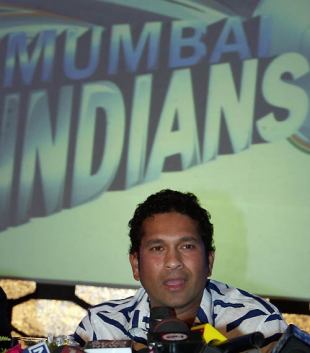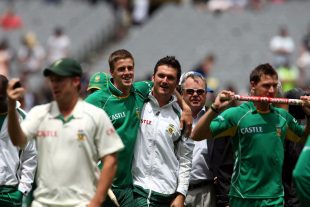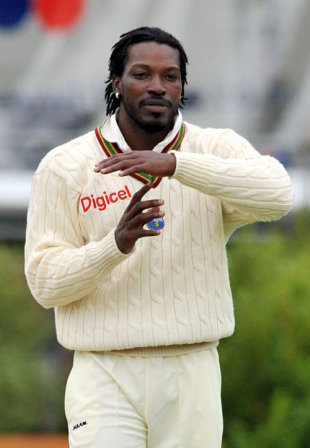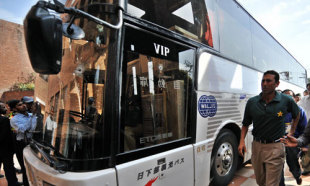Notes by the Editor
Scyld Berry

|
|||
|
Related Links
|
|||
It was a son et lumière worthy of the Sphinx or Grand Canyon. The opening ceremony of the Indian Premier League, on a shirt-sleeve evening in mid-April in Bangalore, was the most spectacular that cricket has seen. I sensed the same ingredients of success at the first official day/night international, between Australia and West Indies, at Sydney in 1979: people hurrying to a ground to see the cricket they wanted, of the duration they wanted, at the time they wanted.
Brendon McCullum lit up the night sky as brilliantly as the fireworks by hitting 158 from 73 balls, and most of the major talents in world cricket joined in over the next six weeks. While there were initial doubts about whether Indian crowds and television audiences would identify with an Australian or South African, and a sizeable proportion of each crowd was admitted free, city-based cricket soon became as popular in India as soap operas. In spite of the poor television camerawork, and advertisements that shaved many overs to five balls, tens of millions - perhaps hundreds of millions - watched, for evening after evening, live cricket.
The IPL is a clever mixture of ingredients because its administrators have understood their market - their mass market. Although it is impossible to be sure from such a recent perspective, it looks as though the supranational IPL is the single biggest change in cricket not merely since the advent of the limited-overs game in the 1960s but of fixtures between countries in the 19th century: that is, since the invention of international or Test cricket.
Above all, until the time of writing, the IPL has had luck on its side. As the world went into economic crisis, the IPL gave every appearance of bucking the trend. The two auctions of players which it staged, the second on February 6 this year, must have appealed to anyone who has played Monopoly: they gave the franchise-owners the feeling they had power over the world's finest cricketers, and everyone else the illusion. At a time of the most serious recession since the 1930s, Andrew Flintoff and Kevin Pietersen were signed for two years at $1.55m per six-week tournament (or pro rata for the number of games they played). The IPL radiated wealth, well-being, exuberance, and prospects for future growth: in a word, hope.
All action, no drama
It was during the third IPL match, in Delhi, that the principal defect of 20-over cricket became apparent. Shane Warne led the Rajasthan Royals against the Delhi Daredevils - and was anonymous. It was not simply that his bowling was ineffective on a flat pitch, or his innings brief, or his captaincy unable to avert a large defeat. The defect was that he had no time to manifest his personality.
Warne's strength of character soon made itself felt, as he turned what had seemed in Delhi to be a bunch of Indian club cricketers into the first IPL champions. But on the field, such is the bustling pace of the 20-over game, Warne had no time to transmit his personality to spectators or television viewers; and the interplay of personalities is the essence of drama. A 50- over game can sometimes allow the necessary scope: remember how Warne, gradually but inexorably, bent the 1999 World Cup semi-final at Edgbaston to his will. But although a Twenty20 game offers plenty of action over three hours, and an exciting finish almost as often as not, it lacks the drama that a full day of intense cricket provides. As the novelty of 20-over cricket wears off, it will be seen that cricket's characters can only be formed in longer versions of the game.

|
|||
The flattery of imitation
Administrators could not cash in quickly enough. The ECB announced the English Premier League, with 20 teams, to start in 2010 (when the recession bit, the two overseas teams were quietly dropped, along with other modifications). An alternative business plan of a nine-franchise league, based at England's international venues, was proposed by Keith Bradshaw, chief executive of MCC, and David Stewart, Surrey's chairman; but it was seen as the thin end of a wedge which would have driven half of the 18 counties out of existence. I am in favour of 18 first-class counties, provided - and it is a provision far from being fulfilled - they devote much more of their resources to promoting cricket within their own communities, instead of relying for recruitment on public schools and the southern hemisphere. These two breeding grounds each supplied about one third of England's county cricketers last season, while Britain's inner cities remained mostly untrawled waters.
The Pro-Active South London Schools Survey 2008 should ring like a fire alarm at the ECB's offices. More than 26,000 children at secondary schools in south London were asked which three sports they would like more access to: football was first, badminton eighth, cricket 21st. Even among boys alone, it ranked no higher than 12th. A major factor is the virtual disappearance of Afro-Caribbean cricketers (see page 60). Such findings show that the hold on the public imagination which cricket had in 2005, when the Ashes were regained in south London, has been lost completely.
As well as the midsummer English Premier League, which was a good idea, the ECB announced a late-summer 20-over competition, which was not. Filling up the domestic season with four competitions is the surest way to prevent an improvement in standards, and has been since 1972. It is only right that the counties should want to do more to stand on their own financial feet, to be less dependent on the £1.5m that the ECB distributes to each one, but two 20-over competitions cannot be right - especially as August is the time to stage 50-over cricket, not May when the ball seams around and powerplays are irrelevant. The only point in favour of the second 20-over competition was that the 40-over league had to be abolished to make space. Launched in 1969 as a fun afternoon to follow the Sunday roast, it had long since outlasted its purpose and become the ball and chain around the legs of English cricket, choking the calendar, preventing the pursuit of excellence, draining intensity out of the system - and the single biggest reason why England, alone among the major Test-playing countries, have never won a global one-day tournament.
Twenty20 stampede
Stampeding began when countries fought to promote a champions league for the winners - and some runners-up - of domestic 20-over competitions. In early June, the ECB declared that a memorandum of understanding had been signed with Australia, India and South Africa; but the English and Indian boards fell out as the latter wanted 50% ownership. The ECB tried to set up their own champions league, and Abu Dhabi's royal family were courted, but they preferred to invest in Manchester City football club.
India went ahead with organising their multimillion-dollar Champions League - before the recession every 20-over league was "multimillion-dollar" - with Australia and South Africa as their junior partners. To make room in the schedule, the First Test in Perth between these junior partners was put back five days: thus 20-over cricket was established as the priority, even though the launch of the Champions League was later postponed a year. Then Sri Lanka's 13 best players refused to tour England for a Test series in May 2009 because they had already pledged themselves to the IPL. In the New Year, England's star cricketers decided they were going to India for half of the second IPL season, even if they returned home only four days before the First Test in May. Christopher Martin-Jenkins observed that Twenty20 was a "Frankenstein which could devour everything unless rationally controlled".
The next stage in the midsummer stampede began with a helicopter hovering over Lord's, landing on the Nursery, and disgorging a self-proclaimed Texan billionaire. Great West Indian cricketers, who had never bowed a knee to any opponent, paid homage to Sir Allen Stanford - or, rather, were paid to pay homage amid the collective sycophancy. The ECB argued, reasonably, that it was better to have such an entrepreneur operating inside the tent, rather than outside, as Kerry Packer had done. But before agreeing to play an annual game of Twenty20 for $20m, for five years, the ECB should have stipulated that their team to play the Stanford Superstars would not be called England, with all the values and traditions which the name implies. Then they would not have been so embarrassed when Stanford's business empire came under investigation in early 2009, and he was charged with fraud "of shocking magnitude". The man who wanted to be king of the Caribbean might not have been what he seemed.

|
|||
The 20-over tournaments proliferated: the IPL, the EPL, the Stanford 20/20 for $20m, a Stanford quadrangular at Lord's, the Champions League, the ICC World Twenty20, and the Indian Cricket League which, having largely confined itself to signing non-Indian players past their prime, recruited a team of Bangladeshis - and further weakened the weakest. Every one was an attempt to cash in, although only the IPL had understood that 20-over cricket needs an extra ingredient to appeal to a wider audience, including women and girls: in its case, the glamorous association with Bollywood film stars and other Indian celebrities. Hence, the IPL is surviving the recession, so far, while the other acronyms are crumbling. The English Premier League has contracted not only in terms of teams but in nomenclature too, down to a proposed, pitiful, P20.
A voice of sanity
Amid last year's tumult came a still, small voice of calm: a cricketer's, not an administrator's. The captain of Sri Lanka, Mahela Jayawardene, spoke on behalf of the whole sport when he said: "You can't have three or four Twenty20 international tournaments a year. You just can't have that. It has to be controlled. Tests are very important; one-day cricket is very important. You can't think that everybody wants Twenty20 cricket."
Almost every international cricketer, when questioned, says the ultimate form of the game is Test cricket: hence the introduction in this edition of the Wisden Test XI, selected from the best performers in the calendar year. Any contest is a purer test of skills if not limited by time: Hector v Achilles could not have been a Homeric contest if limited to five minutes, or a Wimbledon final confined to an hour. Yet these values were not reflected in payments. Some Sri Lankans were being paid a few thousand dollars for a Test and a hundred times as much for a six-week IPL season. Predictions were made, not least by the former England captain Michael Vaughan, that the cricketer of the future would be a mercenary flying from one 20-over tournament to another without ever playing Test matches for his country. Soon afterwards a Sydney club cricketer, David Warner, signed for Delhi Daredevils and brought the Melbourne crowd to its feet with a spectacular innings in a Twenty20 international for Australia, without ever having played a first-class game - or revealed his personality. Administrators must use the profits from 20-over tournaments to cross-subsidise Test match fees.
The England captaincies
In addition to the Twenty20 turmoil, last summer saw the sudden resignation of the England captaincy by Michael Vaughan, and the almost simultaneous departure of Paul Collingwood as the limited-overs captain. Then came the spectacular accession to the Test and one-day captaincies of Kevin Pietersen who, as expected, was no shade of grey: he began by winning everything, then lost everything.
For Vaughan, the strain of being England captain became too much, and it should be asked why. His reign could be said to have lasted five years, but for almost a third of that time his right knee would not allow him to play, and he stepped down from the one-day leadership after the 2007 World Cup. Yet the day after the Edgbaston Test he broke down in tears, saying his personality had been changed so much by the job that he "wanted to be me again". It has become customary for England captains to resign in tears, not far from a breakdown, and it should not be.
Pietersen's reign lasted five months and, as Vaughan could not be persuaded to stay, it was an experiment worth making. The temptation to promote Pietersen was akin to a child being left alone in a chemistry lab: put all the most inflammable ingredients together and see what happens. The resulting spontaneous combustion overwhelmed the South Africans, after they had achieved the primary purpose of their visit, winning the Test series; and the Pietersen experiment might just have lasted long enough for the Australians to be consumed this summer.
Pietersen, unlike Vaughan, never ceased to be himself; perhaps he was even more "me" than he had been hitherto. On the tour of India he grew rapidly into the diverse aspects of the role. But his essential attribute, beyond or rather behind the showmanship, was his obsessive pursuit of excellence, of the kind that made English people wary of Geoffrey Boycott or Nick Faldo: he wanted to achieve perfection in a hurry, without taking people with him. Andrew Strauss was the safest pair of hands waiting under the high wire. More slowly and surely, he will take people with him.
Both Vaughan and Pietersen found it difficult to get the best out of their players while Peter Moores was coach; so, to a lesser extent, did Paul Collingwood as one-day captain. The ECB had appointed Moores in April 2007 without interviewing any other candidates, which is not something they will do again in a hurry. Even then, he might have been the right man for the job if there had been more succession-planning and he had received more mentoring from his predecessor, Duncan Fletcher: how to handle the big personalities in the dressing-room; what tempo to set (Moores pushed the players too hard in training); and how to analyse oppositions (superior intelligence might well have prevented England losing home Test series to India in 2007, ending a six-year unbeaten run, and to South Africa last summer). Moores was forced to learn from his mistakes, which resulted in England losing Vaughan, the captain who had been anointed to lead them into this summer's Ashes.
Another nail in Vaughan's captaincy was the selection of Darren Pattinson for the Headingley Test. Pattinson was a bowler of Test standard in English conditions. The trouble was that no one saw him as English, least of all himself; identity matters in Test cricket, if not in the IPL. As editor of Wisden, Sydney Pardon wrote that a certain selection in the 1909 series "touched the confines of lunacy. The despised man in the street could not have been guilty of such folly… Winning by two to one… the Australians played magnificent cricket, their fielding, for sustained excellence, surpassing anything I can remember in a series of Test matches." A hundred years on, the reference to the Australians has only to be changed to "South Africans".

|
|||
Morris major
In the hope of avoiding future blunders, the ECB had appointed Hugh Morris as "Managing Director - England Cricket", in accordance with the Schofield Report. Towards the end of last year, Morris accomplished two difficult jobs: first, he coaxed the entire England team back to India after the terrorist attack on Mumbai without overt arm-twisting; secondly, he closed the fault-lines which were publicly appearing in the team, by sacking Moores and replacing Pietersen with Strauss, although Pietersen understandably felt let down. Morris illustrated how the best cricket administrator is likely to have played the game himself, then proceeded to gain management and business qualifications. A contrast with all the West Indian administrators who staged the Second Test against England at the Sir Vivian Richards Stadium in Antigua on a sandpit.
Quantity, as usual
To stop more captains resigning before their time, the ECB must also reduce England's schedule, even if some use part of their vacation to play IPL. Pietersen admitted to being exhausted after six weeks in the job, and was saved from flying to Pakistan for the Champions Trophy only by its postponement on security grounds. It is not that England's cricketers play too much; it is that they travel too much, and often do not play enough. Being away from home without the fun of playing cricket is the worst of both worlds, as Marcus Trescothick informed us.
The word "suffer" is used too often in cricket, but in his autobiography Trescothick was entitled to use it in describing much of what he endured in six years as an England player. Why do England cricketers spend so much time on the road and at airports? In every Test-playing country the domestic structure has to be subsidised by the international team, but it is a question of degree: the England team generates about 80% of the annual revenue of English cricket, mostly through the broadcasting deal with Sky, and more than half of that income goes to the 18 counties. They, in turn, should not be spending so much of it on salaries for cricketers, primarily from the southern hemisphere, who are not qualified for England. Only half a dozen people paid at the gate to watch the fourth day of the Championship match between Warwickshire and Northamptonshire, not merely because it was destined for a draw, but also because too many of the players involved were neither famous nor familiar. A reliance on young English cricketers would lower the standard of county cricket in the short term, yes, but would improve the England team in the long term, especially in the limited-overs game.
There were strong arguments for and against the ECB's renewal of their deal with Sky for the period from 2010 to 2013. They negotiated top dollar in midsummer, moments before the credit crunch turned into recession: the price was reported to be £300m. But the continued absence of live cricket from free-to-air television will do nothing to attract those 26,000 children in the Pro-Active survey, and will accelerate the game's evolution into a minority sport for the white and Asian middle class to watch and play. The ECB blamed the BBC for blowing most of their sports budget on Formula One motor-racing. However, the most important fact remains that a generation is growing up without seeing cricket and cricketers; and I object to the fact that the majority of pensioners are also being deprived for at least eight years. Millions of old people, perhaps sitting all day with little to do, have been denied the pleasure of seeing live cricket for the rest of their lives.
England playing so much that the captaincy becomes an unsustainable burden (and at least one player has a nervous breakdown); a broadcasting contract with a satellite company which pays big money but removes the game from free-to-air and the public consciousness; counties employing too many cricketers from overseas; the England team playing all the time and never peaking or consistently winning… They all stem from the ECB's erroneous system of priorities.

|
|||
New world order
The major story of 2008 on the field was Australia's loss of supremacy in Test cricket in all but official terms, while in 50-over internationals their decline culminated in January this year when they were deposed as No. 1 in the ICC rankings by South Africa. Australia's Test dominance had lasted about 14 years, as had the immediately preceding reign of West Indies. Australia's supremacy from 1934 to 1953 lasted about the same time when war years are deducted, a coincidence for which I can see no explanation.
It was after reaching an apogee of 16 consecutive Test wins in January 2008, equalling their own world record, that Australia plummeted. Perhaps it was a curse which Anil Kumble placed on Ricky Ponting's team after India's Test in Sydney, when he said that only one side was playing within the spirit of the game. Injuries afflicted their bowlers; batsmen who joined the IPL, notably Matthew Hayden, Mike Hussey and Andrew Symonds, lost form, in Hayden's case terminally; and their fielding was surpassed by South Africa's. Of the Australian side at Lord's in 2005, only four are playing Test cricket four years on. Hayden, Justin Langer, Damien Martyn, Adam Gilchrist, Shane Warne, Jason Gillespie and Glenn McGrath - a few candidates there for an All-Time XI to face Mars - are gone.
England, owing to their internal disorder, were not one of the countries grasping at the crown as it slipped from Australia's head. India softened up the world champions when they inflicted on Australia their first Test series defeat since 2005, then South Africa became the first side to topple them in a home series since 1992-93. South Africa were admirably led by Graeme Smith who - unlike the Australians - seemed to have benefited from playing in the IPL, under Warne. (It could be that the IPL dilutes a cricketer's intensity when he returns to represent his country: Smith, an exception to this rule, needed to relax; and learned how to do so there.)
South Africa arrived in Australia having already won a Test series in England for the first time since the apartheid era. They blended their traditional virtues of fine fielding and discipline in batting and pace bowling with a flair they had seldom if ever possessed. Jean-Paul Duminy caused much excitement - and won himself almost a million dollars per IPL season - by playing two match-winning innings, and used his feet to spin as very few South Africans have ever done. On his debut in Perth, when South Africa achieved the second-highest successful run-chase in Tests, Duminy skipped down the pitch to off-drive an off-break for six. Duminy comes from the same racial community as Basil D'Oliveira and Ashwell Prince, who last summer played a match-saving hundred at Lord's and a match-winning one at Headingley. One could only regret again the prejudices of all the people complicit - inside and outside South Africa - in suppressing the majority of their population for most of their cricket history. We still await the first black South African Test batsman, such is their legacy.
Sehwag raises the bar - and the roof
India's part in toppling Australia was based not so much on superior spin as on better opening batting, pace bowling and captaincy. Virender Sehwag set the tone by scoring faster during the calendar year than any top-class opener has ever done on a regular basis. Facing only the strongest opposition, Sehwag scored at 85 runs per 100 balls and still averaged well over 50.
If the term "great" is reserved for the best 20 or 30 Test innings ever played, Sehwag produced two of them last year, one against pace, the other against spin. Against South Africa in Chennai - admittedly on a belter, but faced with fine pace bowling and fielding, not to mention Graeme Smith's captaincy - he hit 257 runs in a day, by far the most in the post-Packer era. And against Sri Lanka in Galle, after India had gone 1-0 down, Sehwag carried his bat for 201 out of 329 against the first pair of mystery spinners ever deployed in a Test match. In the same three-Test series, the triumvirate of Rahul Dravid, Sachin Tendulkar and Sourav Ganguly scored one fifty between them. While they were bewildered, Sehwag raised the bar. When he was at the crease, India played in the same aggressive vein as West Indies had done from 1980 to 1994, and Australia from then until last year; and rather more graciously. This is why Wisden's Leading Cricketer in the World is Virender Sehwag (see page 94).
One small step for a woman
Just as defeating Australia in Australia is the ultimate achievement for English male cricketers, or those of any other country, so it is for female ones. Last year England Women retained their own Ashes by winning only their fourth Test in Australia, then went through the summer undefeated. Graeme Fowler, a TV commentator who saw them in Taunton, said they were the best national team England had in any sport: the best trained, the furthest ahead of their rivals, the national team which made the most of their resources. Ahead of the women's World Cup in Australia, the ECB should be congratulated on what they have done for the women's game since taking control a decade ago. They have made the national team the priority, unhampered by the late- Victorian county structure of the men's game, which leads to the tail wagging the dog.
Partly in recognition of this general progress, one of Wisden's Five Cricketers of the Year is Claire Taylor, who rose to the occasion in the Bowral Test by batting England through to victory, and who during the summer established herself as the leading batsman in women's cricket in England and the world. Wisden has never set any parameters, such as limiting the Five Cricketers to men; and there is no element of political correctness or publicity-seeking about her selection. The best cricketers in the country should be recognised, irrespective of gender. Taylor has been chosen on merit, for being pre-eminent in her form of the game.

|
|||
Fair play for umpires too
A worthwhile experiment took place during the 20-over Stanford tournament in Antigua. The two on-field umpires combined with the third (television) umpire to arrive at a collective decision. It was called the consultation system, to distinguish it from the referral or review system which the ICC trialled during the year, starting with the Sri Lanka v India series. The inherent defect of the review system is that players overtly question the judgment of the on-field umpires. When England had their first taste of it, the First Test in Jamaica was an unsightly mess, and not merely because they were dismissed for 51. If players are seen questioning the umpire's decision, the consequences in the lower, non-televised, reaches of the game cannot be calculated, but can only be damaging. In contrast, in the $20m match, justice was done, and seen to be done, without any embarrassment to umpires. Consultation merits an extended trial as soon as possible.
Overall, though, the ICC deserve to be congratulated on improving the quality of umpiring in international cricket. Those annoying instances of left-handed batsmen being given out lbw to balls pitching outside leg stump are now very far between. Another improvement occurred when David Morgan took over from Ray Mali as ICC president, and told umpires not to be so fussy about bad light. There was all the difference between the first Lord's Test being ruined by umpires applying southern hemisphere standards, and the second Lord's Test which carried on in bad light and drizzle. Play should not continue if dampness affects the ball. Otherwise, long may the new guidelines be applied.
Eating into lunch
The tempo of umpiring, however, must be quickened. Some umpires are as much to blame for slow over-rates as players. In the Chennai Test between India and England, the fourth umpire bore a banana on to the field for Billy Bowden, then returned to take the skin back to the pavilion. In the same match England sent a substitute on to the field to give a lengthy message to the captain Kevin Pietersen - in the middle of an over!
These intrusions must stop, for two main reasons. It is an essential feature of cricket that the players should think for themselves: Bob Woolmer's radio contact with Hansie Cronje in the 1999 World Cup at Hove was the most extreme violation. Secondly, the over-rate must be increased from its current level: 13.79 overs per hour in Test matches in 2008, according to the Sky statistician Benedict Bermange - the fourth consecutive year it has been below 14. Worse still, the rate of 15, supposedly mandatory, has not been achieved since 1979. This is an appalling statistic and a grave criticism of all those culpable: from the ICC, whose penalties have had too little effect, to national boards who have failed to remind captains of their responsibilities, to the players themselves. In an unquantifiable measure, they have all contributed to driving crowds away from Test cricket and into the outstretched arms of Twenty20.
I am opposed to dealing with this problem by means of run penalties: they would distort a Test match as the purest contest of skills, and encourage the batting side to slow the rate down further with ploys of gamesmanship. Instead, I urge the consideration of two proposals:
1. The boundaries should be sealed during play, except at the hourly drinks break or in exceptional circumstances. Nobody extraneous should be allowed on to the field at other times: no twelfth men taking fresh gloves or drinks or messages to the batsmen, no substitutes carrying out drinks and helmets and sweaters for the fielding side, no fourth umpires bearing meters or new balls or bananas. No changing of the old ball either, except at the drinks break: the bowling side chose it and they can lump it, at least until then. Let the field of play be sacrosanct again.
2. The ICC should adapt this adage: the way to a man's heart is through his stomach. The fielding side should keep bowling into the lunch interval until they have completed 30 overs for the morning session. In the afternoon, when spinners are more likely to be used and the over-rate is slightly quicker, they should likewise bowl into the tea interval until 30 overs have been completed. There would have to be a minimum break of ten minutes at lunch and tea for health and safety reasons. But, soon enough, fielding sides that dawdle would become very unpopular with umpires who miss out on putting their feet up, commentators who want their lunch, and caterers who lose customers, while broadcasters and spectators are finally given full value for money.
The umpire's decision is final/not final/finally final
Last year, for the first time, the ICC held its annual meeting somewhere other than Lord's, in Dubai. There it changed the result of the 2006 Oval Test between England and Pakistan from a forfeiture to a draw. The ICC, at a stroke, forfeited respect. What right does the governing body have to punish a player for disobeying the umpire, when it disobeys not only the umpire's decision but the very Laws? "Once the umpires have agreed with the scorers the correctness of the scores at the conclusion of the match… the result cannot thereafter be changed" (Law 21.10).
The proposal was made by the chairman of the Pakistan Cricket Board, Dr Naseem Ashraf. It was indefensible for leaders of other countries' boards to support him - enough of them to carry the motion - for the sake of political expediency. Being composed mostly of former cricketers, with some notions of fair play, the cricket committee rejected this proposal out of hand. But the ICC executive board accepted it, and changed the result to a draw - until the U-turn at their New Year meeting in Perth. In any event, Wisden was going to uphold the Laws of the game and ignore the ICC's original decision. Whatever the rights and wrongs at The Oval, the result of the England v Pakistan Test series of 2006 was, and always will be, 3-0.

|
|||
There but for the grace
Cricket needs to record with gratitude the name of Reg Dickason, the security officer who advised against the Champions Trophy going ahead in Pakistan last September. According to the original schedule, England, and probably South Africa and New Zealand, would have been staying at the Marriott Hotel in Islamabad when a lorry, driven by a suicide bomber and packed with explosives, drew up at the hotel gates.
In addition to missing out on staging the Champions Trophy, Pakistan did not play a single Test in 2008. They played a "home" one-day series against West Indies at the splendid modern stadium in Abu Dhabi, but a neutral venue is no substitute for generating public interest and revenue. The ECB made a pitch for hosting some of Pakistan's matches in England, but that was not a worthy suggestion. We should try to help Pakistan bind itself together and make it work properly, not carve it up.
The terrorists who attacked Mumbai on November 26 were reported to be from Pakistan. One of their main targets was the Taj Mahal Hotel, beside the Gateway of India. If anywhere in the world could have been called "the cricket hotel", it was the Taj. Two South African security officers, who had arrived to protect officials drawing up regulations for the new Champions League, organised a large part of the defence of the Taj from within. Faisul Nagel, an England security officer on more than one tour, and Bob Nicholls should be remembered for helping to save approximately 150 lives.
If a terrorist attack can have a silver lining, it was that the Indian board and the ECB came closer together. Not alone, I took angry exception to the IPL chief commissioner Lalit Modi proclaiming that England's Test series in India would go ahead while the siege of the Taj was still going on. A far better statement of propriety and human decency came simultaneously from India's captain, the highly impressive Mahendra Singh Dhoni, who said: "We are entertainers, and now is not the time to entertain." It was obvious that Modi's prime concern was to ensure that the second IPL went ahead.
Ideally, England would not have gone back to India so quickly: playing 12 days after the Mumbai attacks must have been insensitively soon for some of the bereaved. By then it was also apparent that India's tour of Pakistan would be cancelled, and most of January would have been free for both countries. But better that the tour went ahead when it did than not at all. And, in the aftermath, the English and Indian boards realised that what united them was greater than what divided them, especially in a major economic crisis.
During this recession, the failures of western-style capitalism were widely discussed; and it was tempting to hope that cricket's administrators would reassess their values too. Balance should be the objective, as Jayawardene said: the best not the biggest, the most watchable not the most lucrative, the optimum amount of cricket not the maximum. The professional game, too, had to learn that the pursuit of short-term profit had brought the world of barely regulated capitalism to disaster's brink.
Looking forward
Nevertheless, in spite of all these problems, the fundamental fun of bat and ball remains unchanged. Whenever I play, our club ground is as green and tranquil as ever, without any son et lumière or substitutes running on or helicopters landing; and the play as absorbing, the tea as delicious, the banter as witty, the drink as refreshing.
Even though the English summer of 2009 is unprecedentedly packed, it should generate much pleasure, especially as an escape from recession. It offers the best of old and new: the Ashes and a Twenty20 world cup. The only prophecy about this Ashes series that can be made with confidence is that it will be close. The Twenty20 tournament, unlike the last two 50-over World Cups, could be won by any of the eight main Test-playing countries.
An astonishing, unique, game in all its forms. Cricket has regenerated and grown, over the centuries, as no other sport has done.

